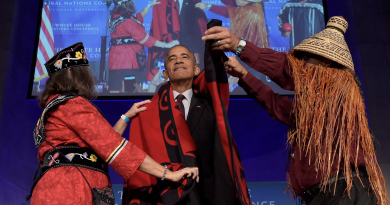Russian Arctic rescue exercise attended by observers from Iran and Saudi Arabia

The exercise called “Secure Arctic 2023” included 16 scenarios and was held in nine Russian Arctic regions, from Murmansk in the west to Chukotka in the east. More than 60,000 people were engaged in training activities, the Emergency Ministry (Emercom) informs.
The training was held only few weeks before Russia completes its two-year presidency in the Arctic Council.
Among the scenarios was a chemical leak from a railway cistern in Arkhangelsk region and a helicopter crash at a remote location in the Nenets Autonomous Okrug. In Murmansk, more than 1,000 people were involved in training how to extinguish a major fire at a train and evacuation of passengers. There was also training around one of the nuclear-powered icebreakers docked in the Murmansk Port.
“The series of educational, practical, scientific studies and arrangements have demonstrated the ability and readiness of the Emergency Ministry’s forces and facilities to act at harsh northern altitudes,” Minister Aleksandr Kurenkov said in a sum-up after the exercise.
According to Kurenkov, there is a growing interest in Arctic security across the international community. He himself greeted the 39 foreign observers from 13 countries.
“Your participation is a clear confirmation of the interest in the Arctic and [our] humanitarian mission on the international level, as well as a demonstration of our openness and readiness to strengthen cooperation in the field of security,” he told the guests.
“No problems” when it comes to humanitarian issues, says Iran rep
The foreign observers represented Belarus, Kazakhstan, Mozambique, Serbia, Nigeria, Kirghizia, Bosnia and Herzegovina, Ghana, Iran, Laos, Mongolia, Saudi Arabia and Eswatini, Rossiiskaya Gazeta reports.
The leader of the Iranian delegation told the newspaper that he had talked with, and even prayed with, the representatives from Saudi Arabia.
“We have no problems with any country when it comes to humanitarian issues and rescue of human lives in accidents,” he said.
Minister Kurenkov took over the post following the death of predecessor Yevgeny Zinichev in an accident during the Ministry’s previous Arctic exercise in 2021. Under unclear circumstance, Zinichev reportedly died when trying to rescue a cameraman that had fallen down from a cliff near the city of Norilsk.
According to official sources, the 55 year old top minister jumped into the waters where film maker Aleksandr Melnik had fallen. In the jump Zinichev hit his head against a rock and lost his life.
Kurenkov appointed to Emercom in May 2022
Aleksandr Kurenkov comes from the FSB and before his appointment in Emercom in May 2022 served as Deputy Head of Russia’s National Guard (Rosgvardia). He reportedly was on a mission in Ukraine during Russia’s first months of onslaught on the neighboring country.
Before the war, Emercom was engaged in a series of international exercises with neighboring European and Nordic countries. Among them was Barents Rescue, the civil international crisis management exercise with participation from Finland, Norway, Sweden and Russia.
The 10th Barents Rescue was originally to be held in September 2022.
Related stories from around the North:
Canada: Int’l arctic cooperation needs to continue despite rupture with Russia: Canada’s GG,The Canadian Press
Finland: Russian cyber attacks, espionage pose growing threat to Finnish national security, Yle news
Greenland: Growing focus on Arctic puts Greenland at higher risk of cyber attacks: assessment, Eye on the Arctic
Iceland: Nordics should aim for common approach to China’s Arctic involvement says report, Eye on the Arctic
Norway: As NATO flotilla exercises along North Norwegian coast, Russian vessels lure in nearby waters, The Independent Barents Observer
Russia: Moscow lowers ambitions in nuclear icebreaker program, The Independent Barents Observer
Sweden: Swedish armed forces ready and waiting to join NATO as Finland becomes member, Radio Sweden
United States: U.S. nominates Alaskan as first Arctic ambassador, Eye on the Arctic



